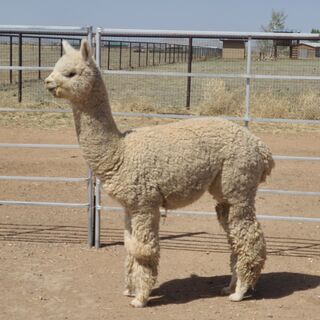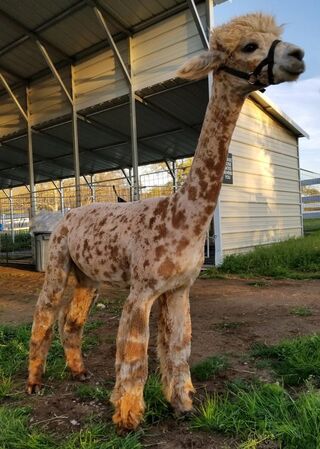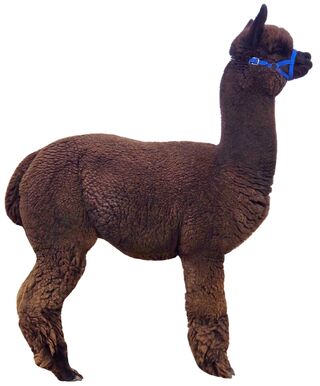BIRTHING CRIAS
BIRTHING CRIAS
In Advance
Take a neonatal class repeatedly to be properly prepared for birthing crias. Once is not enough. Dystocias (Difficult Births) are rare but do happen. We’ve been told by a vet that most of them involve a retained leg. We have seen a number here with that issue.
One text has been recommended repeatedly as the best source of birthing information for Camelids:
https://www.useful-items.com/product-p/109nc.htm
As your pregnant dams approach delivery be sure to have colostrum either powder or Goat colostrum in your freezer in the event there is nursing issues. This is very important! We use the powder form from Tractor Supply. Generally, you will be able to find a goat farm that will sell it to you. They freeze it regularly. It will be stored for three years. Allow it to defrost at room temperature
Cria Kit
Prepare a “Cria Kit” with the needed supplies in it. We have ours in a large hard plastic toolbox. To be properly prepared for birthing crias it should contain:
• Lots of Lubricant—more than you would think, available from feed stores; KY Jelly will work in a pinch, but it is much more expensive.
• Rubber gloves, the ones that reach up to your shoulders.
• Nolvasan (generic is chlorhexadive 2%) for several dips of the umbilicus on the first day.
• A flat jar or small tray to hold the above when dipping the cord if not using a spray bottle.
• Hair dryer, for use on cold days
• Old clean sheets and blankets (stored separately in a box)
• Digital thermometer, which needs to be checked seasonally for battery strength and accuracy.
• Sterile Gauze sheets for use as needed.
• A shoestring to tie up a slowly expelled placenta to prevent the dam from walking on it. (Gravity is all it needs to be expelled. Never pull it out.)
• Calcium pastes for the dam if she becomes overly tired.
• Empty liter sized soft drink bottle. We use a human baby bottle with a nook nipple.
• Pritchard nipples for the soft drink bottle: be sure to test and if needed cut a tiny hole to allow a cria to suck milk.
• A chair to sit down on and watch the birthing process so you don’t get unnecessarily involved. Nature usually works its way out 95% of the time, if not more.
Complete kit:
https://llamaproducts.com/herd-health/baby-care/complete-baby-kit.html
Labor and Delivery
When a cria is being born, 90% of the births occur between 7 am and 3 pm. There are obviously exceptions. We have experienced a 4 am once in 7 years.
Check on your expected dams during the last two weeks regularly. Especially if there are bad weather conditions. Since we have tours throughout the day we are checking every couple of hours. The timed checks get closer the later they go.
Once you see a pregnant Dam isolating herself from the herd and making frequent trips to the poop pile without defecating or urinating, she is most likely in labor.
When a dam is in labor, they should progress fast—45 to 75 minutes—once the baby starts to come out. The nose and two feet above it should be visible. They don’t always show up at the same time. And if you only see one, don’t immediately panic. Sometimes it takes a little bit for everything to be visible. The “breathing that you witness before the baby is most of the way out is “practice” breathing. Their oxygen is still being supplied via the umbilical cord.
Labor Issues
If the dam stops progressing halfway through the delivery don’t jump in immediately and assist. The dam needs some “hang time” for her final pushes. Some dams labor standing up, others cushing sternal, and others on their side.
If you have a dam that has gone past a normal hang time, you can give the dam some calcium paste. Available in what looks like a tube of caulking compound—to help her muscles get through this strenuous time. It does get old so you might need to purchase it annually. Another possibility is to use 3-4 Tums with Calcium that can be ground up and given via an oral slurry.
The birth canal of the Alpaca is straight down at the very end. If you absolutely must get involved do so with rubber gloves and LOTS of lubricant. Only do so when it becomes obvious the dam has stopped progressing and will not restart.
The following issues involving birthing crias are major complications. Though rare, it’s best to be prepared in advance.
Uterine Torsions
This is when the uterus twists 180° inside the dam. It is a very dangerous and uncomfortable situation for the dam. Many times, this happens because of a pregnant dam rolling in a dust area or when visiting a new field and rolls.
The condition is not possible to diagnose from just an external examination of the dam. If you have a pregnant dam in the later months of term that is acting off/not normal, a uterine torsion should be a possible consideration for you. After scrubbing up, putting on sterile rubber gloves and getting plenty of lubricant on, press one finger into the vaginal opening. If you immediately feel a twisted tissue you, likely, have a dam with this condition. Exit the animal and call a veterinarian stat.
It is difficult to visualize how to rotate the uterus to untwist. If the uterus is twisted clockwise (from the perspective of looking at it from mom’s vaginal opening), one would want to untwist it counterclockwise—if one could rotate the uterus itself. The opposite if the twist is counterclockwise. An inflated balloon is an excellent visualization tool if that helps you. Since you are trying to untwist by rotating mom around the uterus, you need to roll mom in the same direction that the uterus just went.
There are several ways to untwist the uterus. One approach is to use a board to try to hold the uterus–fetus in one place while rotating mother around it. Another is to hold the uterus in two ways—one hand is internal and one external. Both put pressure on the uterus to stay put, while another person or two slowly rotated the female’s legs up and over to the other side.
Dystocias
Technically speaking these are difficult births. In the years we have had in birthing crias we have had several of these. But these are fortunately not a common event in birthing crias.
One Elbow Flexed
The most common is a head and a single leg out and the other leg retained. Sometimes this can be with the foot forward; other times this can be either entire leg retained. We have experienced this once with a successful delivery.
As always, after scrubbing up, putting on sterile rubber gloves and getting plenty of lubricant on, you will need to push the head back into the dam. (Don’t worry, the cria is still getting oxygen via the umbilical cord.) With your hand inside the dam carefully feel down the chest of the cria to find the hidden leg. Then trace the leg down to the knee. With our experience we had only the elbow flexed. The toes and ankle were already pointed up. You will need to pull the knee forward to an extended position. Then trace the leg down further to the fetlock and ankle. Pull the ankle toward you.
If you are unsure if you have a hold of a leg and are trying to decide if it is a front leg or a back leg, check the first two joints. If they bend the same way, then they are the fetlock and the carpus (front “knee”) and you have a front leg. If the first two joints bend in opposite directions, they are a fetlock and a hock so it is a rear leg.
Other More Difficult Dystocias
We have had one of the following and our cria did not survive.
• Legs OK, Neck Flexed Backwards
• Legs OK, Neck Flexed Downwards
Breech Births
This is when the orientation of the cria is backwards in the dam—either butt first or back feet first. The condition is not possible to diagnose from just an external examination of the dam, but there can be some obvious external signs—dam is cushed for a very long time with no obvious progress. Sometimes there is an external drip of fluid on the vulva.
To diagnose, after scrubbing up, putting on sterile rubber gloves and getting plenty of lubricant on, press one finger into the vaginal opening. If you feel a tail—which is not the expected nose—you have a dam in frank breech. To know if the cria is alive or dead in frank breech, gently poke your finger in the cria’s anus which is just under the tail. If the cria is alive you will feel movement and a squeezing around your finger. If not the cria is dead and there is no hurry to get it out. You can wait as long as needed for the vet to arrive.
When the cria is alive time is more crucial. If the vet cannot get there in 30 to 45 minutes you may need to try to deliver the cria yourself. To do this safely you do need to understand the anatomy of both the dam and the cria. A class is the very best way to acquire this knowledge and practice it ahead of time but if a class is impossible get the book and read it through from cover to cover three times and then go back and make notes, etc.
https://www.useful-items.com/product-p/109nc.htm
Please note—it is nearly impossible to turn a breech to headfirst. Delivering them feet first is almost always needed. For a frank breech, i.e., tail first with all four legs forward, it is still necessary to do some complex manipulation to get the feet out. The key to a successful breech delivery isn’t pulling harder – it is getting things repositioned quickly and enough to bring it out feet first. Pulling too hard in the wrong position can cause damage to both.
Something You Should NOT Do
NSAIDs like Banamine inhibits production of prostaglandins which are important in signaling the initiation of parturition. The use of Banamine (flunixin) can delay parturition and prolong labor which may increase the risk of stillbirth. Do not use Banamine (flunixin meglumine injection) within 48 hours of expected parturition. In plain language, do not use Banamine in an expectant dam that is close to delivery, and don’t give it during delivery or you may end up with a dead cria. Banamine should only be used *after* the placenta is expelled.
POSTPARTUM CARE https://www.plumcreekalpacas.com/page/10286/postpartum-care
Thank you for permissions to use this information. https://www.facebook.com/aubrey.oaks.alpacas
Thursday, January 11, 2024




